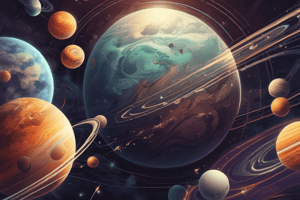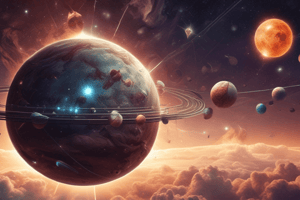Podcast
Questions and Answers
What is the largest object in the solar system?
What is the largest object in the solar system?
- The Sun (correct)
- The Moon
- Jupiter
- The Earth
What is the purpose of the Sun's gravity in the solar system?
What is the purpose of the Sun's gravity in the solar system?
- To hold the planets in place (correct)
- To make the Moon orbit the Earth
- To change the shape of the Moon
- To create asteroids and comets
How many planets are there in the solar system?
How many planets are there in the solar system?
- 9
- 8 (correct)
- 7
- 6
What is the Moon's orbiting period around the Earth?
What is the Moon's orbiting period around the Earth?
Who was the first person to walk on the Moon?
Who was the first person to walk on the Moon?
What is the term for the different shapes of the Moon?
What is the term for the different shapes of the Moon?
What is the region between the orbits of Mars and Jupiter where most asteroids are found?
What is the region between the orbits of Mars and Jupiter where most asteroids are found?
What is a comet like?
What is a comet like?
What happens when a comet approaches the Sun?
What happens when a comet approaches the Sun?
What is unique about Mars compared to the other terrestrial planets?
What is unique about Mars compared to the other terrestrial planets?
What do terrestrial planets have in common?
What do terrestrial planets have in common?
Which planet is known for having the densest atmosphere among the rocky bodies in the Solar System?
Which planet is known for having the densest atmosphere among the rocky bodies in the Solar System?
What is unique about Earth among the terrestrial planets?
What is unique about Earth among the terrestrial planets?
What characteristic do terrestrial planets have in common?
What characteristic do terrestrial planets have in common?
What is Mercury named after?
What is Mercury named after?
What percentage of Earth's crust is covered in water?
What percentage of Earth's crust is covered in water?
What is the primary reason for Mars' orange-red color?
What is the primary reason for Mars' orange-red color?
What is the main characteristic of Jovian planets?
What is the main characteristic of Jovian planets?
Which of the following is NOT a characteristic of Jovian planets?
Which of the following is NOT a characteristic of Jovian planets?
What is Jupiter's mass relative to the other planets in the Solar System?
What is Jupiter's mass relative to the other planets in the Solar System?
What is the composition of Uranus?
What is the composition of Uranus?
Which planet is the densest giant planet?
Which planet is the densest giant planet?
What is the relative size of Saturn compared to Earth?
What is the relative size of Saturn compared to Earth?
How many times more massive is Neptune than Earth?
How many times more massive is Neptune than Earth?
What is a characteristic of Atiras asteroids?
What is a characteristic of Atiras asteroids?
What happens to a comet when it approaches the Sun?
What happens to a comet when it approaches the Sun?
What is the Kuiper Belt?
What is the Kuiper Belt?
What is the main difference between the asteroid belt and the Kuiper Belt?
What is the main difference between the asteroid belt and the Kuiper Belt?
What is the origin of comets?
What is the origin of comets?
What is the composition of a comet's nucleus?
What is the composition of a comet's nucleus?
What is the purpose of studying comets?
What is the purpose of studying comets?
What is a characteristic of Amor asteroids?
What is a characteristic of Amor asteroids?
What is the main characteristic that distinguishes a dwarf planet from a planet?
What is the main characteristic that distinguishes a dwarf planet from a planet?
Which of the following is NOT a characteristic of a dwarf planet?
Which of the following is NOT a characteristic of a dwarf planet?
What is the location of the asteroid belt in our solar system?
What is the location of the asteroid belt in our solar system?
What is the shape of the dwarf planet Haumea?
What is the shape of the dwarf planet Haumea?
Which dwarf planet is located in the Kuiper belt?
Which dwarf planet is located in the Kuiper belt?
What is the size of Eris compared to the Earth's Moon?
What is the size of Eris compared to the Earth's Moon?
What is the characteristic of asteroids?
What is the characteristic of asteroids?
How many dwarf planets are there in our solar system?
How many dwarf planets are there in our solar system?
Flashcards are hidden until you start studying
Study Notes
Exploring the Solar System
- Our Solar System is a system of planets and other objects that orbit the Sun, comprising 8 planets, many moons, asteroids, comets, meteoroids, and tiny particles of rocks and dust.
Formation of the Solar System
- The Sun is the largest object in the Solar System, making up about 99% of the system's mass, and holds everything in place by its gravity.
Planets
- A planet is an astronomical body that orbits a star or stellar remnant.
- There are 8 planets in the Solar System, divided into two categories: terrestrial planets and jovian planets.
- The 4 terrestrial planets are Mercury, Venus, Earth, and Mars, whereas the 4 jovian planets are Jupiter, Saturn, Uranus, and Neptune.
Moon
- The Moon is the Earth's closest neighbor in the sky, taking 7 days to complete its orbit around the Earth.
- The Moon has no life due to the lack of air and water, and its surface features mountains and large bowl-shaped depressions called craters.
- Neil Armstrong was the first person to walk on the Moon on July 20, 1969.
Phases of the Moon
- The Moon appears to change shape every night due to its phases, which are:
- New Moon
- Waxing Crescent
- First Quarter
- Waxing Gibbous
- Full Moon
- Waning Gibbous
- Last Quarter
- Waning Crescent
Asteroids
- Asteroids are small, rocky objects that orbit the Sun, found mainly in the main asteroid belt between the orbits of Mars and Jupiter.
- Asteroids are classified into four groups: Apollo, Atens, Atiras, and Amor.
Comets
- Comets are celestial objects consisting of a nucleus made of ice, dust, and rocky material, and are like "dirty snowballs" traveling through space.
- When a comet approaches the Sun, the heat causes the ice to vaporize, creating a glowing coma (a cloud of gas and dust) around the nucleus.
- Comets originate from the outer regions of the Solar System and provide valuable insights into the early formation of our universe.
Terrestrial Planets
- Terrestrial planets are composed primarily of silicate rocks or metals and have a compact, rocky surface.
- Characteristics of terrestrial planets include:
- Solid surface
- Core containing heavy elements
- Higher overall density
- Fewer moons
- Closer to the Sun
- The four terrestrial planets are Mercury, Venus, Earth, and Mars.
Jovian Planets
- Jovian planets are larger in size and mass, and do not have solid surfaces.
- Characteristics of jovian planets include:
- Less dense than terrestrial planets
- Composed of gases
- Many moons and strong gravitational pull
- Rings
- The four jovian planets are Jupiter, Saturn, Uranus, and Neptune.
Dwarf Planets
- Dwarf planets are celestial bodies that orbit the Sun, have enough mass to assume a nearly round shape, but have not cleared the neighborhood around their orbit.
- There are five dwarf planets in our Solar System: Ceres, Pluto, Haumea, Makemake, and Eris.
Kuiper Belt
- The Kuiper Belt is a circumstellar disc in the outer Solar System, extending from the orbit of Neptune to approximately 50 astronomical units from the Sun.
- It is similar to the asteroid belt but is far larger and more massive.
Studying That Suits You
Use AI to generate personalized quizzes and flashcards to suit your learning preferences.




